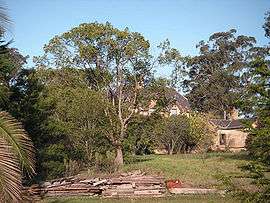St Helens Park, New South Wales
| St Helens Park Campbelltown, New South Wales, New South Wales | |||||||||||||
|---|---|---|---|---|---|---|---|---|---|---|---|---|---|
 St Helens Park House | |||||||||||||
| Population | 6,323 (2011 census)[1] | ||||||||||||
| Established | 1976 | ||||||||||||
| Postcode(s) | 2560 | ||||||||||||
| Location | 56 km (35 mi) south-west of Sydney | ||||||||||||
| LGA(s) | City of Campbelltown | ||||||||||||
| State electorate(s) | Campbelltown | ||||||||||||
| Federal Division(s) | Macarthur | ||||||||||||
| |||||||||||||
St Helens Park is a suburb of Sydney, in the state of New South Wales, Australia 56 kilometres south-west of the Sydney central business district, in the local government area of the City of Campbelltown. it is part of the Macarthur region.
History
St Helens Park draws its name from a Gothic mansion built in 1887 by George Charles Westgarth, a Sydney solicitor. The mansion still stands at the southern end of St Helens Park Drive but it's not the oldest building in the suburb. That honour goes to a farmhouse on Appin Road called Denfield and Curtilage which was built in the 1830s by John Farley of Fisher's Ghost fame. Both buildings are listed on the Register of the National Estate.[2][3][4]
By the 1940s, the St Helens Park property had become a fly spray testing laboratory and acquired the local nickname Blowfly Farm. It was later restored as a residence and grazing property. In 1975, Campbelltown Council designated the area for suburban development and in 1976, it was formally named St Helens Park. Although development was slow at first, it continued throughout the 80s, 90s and into the 21st century.[2]
Schools
There are two primary schools in the suburb. Woodland Road Public at the northern end of the suburb was opened in 1980. St Helens Park Public to the south was opened in 1995. The nearest secondary school is Ambarvale High.[2][5]
Housing
St Helens Park is one of the more modern suburbs of Campbelltown, with new subdivisions taking place as of 2006. The vast majority of new development in the suburb is in the form of detached housing.
Demographics
According to the 2006 census, St Helens Park recorded a population of 6,136. There were higher than average numbers of families (80%) and the median family income of $1154 per week was slightly higher than the national average. The majority of residents were Australian born (72%) and spoke only English (78%) although there were substantial minorities speaking Spanish (2.2%), Lao (1.2%) and Arabic (1.0%).[6]
Transport
St Helens Park is well connected by road to both Campbelltown and Wollongong via Appin Road. The suburb is also serviced by Campbelltown's local bus company, Busways. It has three routes (887, 889, 890), two directly from St Helens Park to Campbelltown and one on the route from Campbelltown to Appin and Wollongong.[7]
References
- ↑ Australian Bureau of Statistics (31 October 2012). "St Helens Park (State Suburb)". 2011 Census QuickStats. Retrieved 17 April 2015.
- 1 2 3 "History of St Helens Park". Campbelltown City Council. Retrieved 2009-06-07.
- ↑ "St Helens Park House and Outbuildings (Place ID 3288)". Australian Heritage Database. Department of the Environment. Retrieved 2009-06-07.
- ↑ "Denfield and Curtilage (Place ID 3269)". Australian Heritage Database. Department of the Environment. Retrieved 2009-06-07.
- ↑ UBD Sydney Street Directory, Universal Publishing, 2007
- ↑ Australian Bureau of Statistics (25 October 2007). "St Helens Park (State Suburb)". 2006 Census QuickStats. Retrieved 2009-06-06.
- ↑ "Macarthur Bus Network Map" (PDF). Busways. Retrieved 2008-04-16.
Coordinates: 34°06′38″S 150°48′28″E / 34.1105°S 150.8079°E